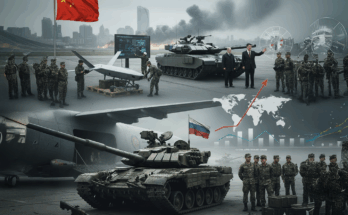
Just over a week after Israel began Operation Rising Lion, a major air campaign against Iran, the U.S. carried out its own series of strikes on Iran on Saturday night, targeting key infrastructure connected to the Iranian nuclear program. “Iran’s key nuclear enrichment facilities have been completely and totally obliterated,” U.S. President Donald Trump declared in an address announcing the strikes.
The strikes on Iran mark a dramatic escalation in the confrontation over Iran’s nuclear ambitions. President Trump characterized the strikes as a one-off, but he noted that there other facilities that could be struck. “If peace does not come quickly, we will go after those other targets,” he said.
Operation Midnight Hammer
Defense Secretary Pete Hegseth and the Chairman of the Joint Chiefs of Staff, General Dan Caine, provided more concrete details of the mission, dubbed Operation Midnight Hammer, in a press conference on Sunday morning. The U.S. strikes targeted three key nuclear sites in Iran — Natanz, Fordow, and Isfahan — and all three of these are believed to have “sustained extremely severe damage and destruction,” Gen. Caine said, though he cautioned that that assessment is still preliminary at this stage.
Over 125 aircraft were involved in the attack. B-2 strategic bombers operating from bases in the U.S. took off early on Saturday, with some heading to the Pacific Ocean as a diversion. Reporting in the U.S. media said these bombers were destined for Guam with their payloads, awaiting a final decision from President Trump – but the go-ahead had already been given, and another set of B-2 bombers was simultaneously flying east to perform the strike. Multiple aerial refuelings took place along the way, and by Saturday evening (Sunday morning local time) the B-2s were in position.
As the bombers approached Iran, they linked up with fourth- and fifth-generation combat aircraft that were used to suppress Iranian air defenses and fighter jets to ensure the bombers would be unhindered in their mission. No American aircraft were lost or seemingly even targeted, and Iran’s military may well not have even been aware of the attack until it happened. “We are currently unaware of any shots fired at the U.S. strike package on the way in,” Gen. Caine stated, and he noted it was a similar story on the way back out, as well.
The bombing itself utilized 75 precision-guided weapons, including 14 GBU-57 Massive Ordnance Penetrators (MOPs), a huge conventional bomb that can only be carried by the B-2. The MOP was designed in the 2000s to breach and destroy hardened defenses, but until Operation Midnight Hammer had never before been used in combat. A dozen GBU-57s were dropped on Fordow, a facility buried under a mountain, while the other two hit Natanz.
The U.S. action also involved a submarine operating in the Middle East region, which launched a salvo of “more than two dozen” BGM-109 Tomahawk cruise missiles at Isfahan.
Iranian Response
Tehran quickly vowed retaliation for the attack. In a Sunday statement, Iranian Foreign Minister Abbas Araghchi said Iran reserved the right to carry out a response. Iran’s parliament gave approval for the country to perform military operations to ‘close’ the Strait of Hormuz, through which as much as 20 million barrels of oil transits daily. Military decisions rest with Iran’s Supreme National Security Council – not the parliament – but the green-light serves as a warning of what steps Iran could take.
The Islamic Revolutionary Guards Corps (IRGC) possesses anti-ship missiles, unmanned surface vessels, and naval mines that all could be utilized to attack shipping through the Strait of Hormuz, in a similar manner to the campaign run by Yemeni militant group Ansar Allah, an Iranian ally, to harass traffic in the Red Sea. Ansar Allah, commonly referred to as ‘the Houthis’ in reference to its leadership, began significantly targeting shipping through the Bab al-Mandab Strait in reaction to Israel’s military campaign in Gaza, and those strikes (and accompanying spike in insurance premiums) prompted many ships to skip the Red Sea altogether and take the longer route around Africa.
Whether Iran takes that step with the Strait of Hormuz is another question. Iran targeted naval traffic in the Strait in the 1980s, amid warfare with Iraq, but did not achieve a ‘closure’ of commerce through the waterway – and the Iranian naval operations brought it into conflict with the U.S. on multiple occasions, such as after the USS Samuel B. Roberts was mined in 1988. Attempting to close the Strait today could moreover strain Iran’s ties with China, which imports a significant amount of its oil via the Strait.
Elsewhere in the region, Iran has a network of militia allies it leans on as frontline forces, although the ‘Axis of Resistance’ is looking worse for wear after a year and a half of Israeli military action. Lebanon-based Hezbollah, still smarting from Israeli operations such as last year’s pager attack, has so far chosen to sit on the sidelines rather than intervene as its patron Iran has come under fire. The Iranian-backed militias in Iraq, however, are in better shape and could seek to attack U.S. bases in the country. Ansar Allah remains in control of Yemen’s capital and has warned it could resume hitting traffic in the Red Sea.
At home, U.S. agencies have warned of a “heightened threat environment” over the possibility that Iranian cells could perform terror or cyber attacks on the U.S. homeland.
Any Iranian action bears with it the possibility of significantly escalating Washington’s involvement. A U.S. official told Axios that President Trump “doesn’t want to continue strikes on Iran,” a stance the American leader reportedly conveyed to Israeli Prime Minister Benjamin Netanyahu in wake of the B-2 strike. That position would change were Iran to seriously hit U.S. interests or personnel in the region.

In early 2020, during the first Trump administration, an American operation killed the head of the ‘Quds Force’, Qassem Soleimani, who was the point man for and key architect of the IRGC’s foreign operations. Tehran retaliated several days later with a missile salvo aimed at the U.S. deployment at Ayn al-Asad airbase in Iraq. The Iranian barrage was reportedly telegraphed ahead of time, and no Americans were ultimately killed in the attack. (Though dozens of American troops suffered traumatic brain injuries.) Whether Tehran intended for that attack to kill U.S. troops, no further action came from Iran directly after that salvo, and thus the situation saw no further escalation.
A symbolic Iranian retaliation would be the ideal scenario for Washington, but there’s no telling whether Iran would view such a reply as sufficient given the drastically different circumstances this time around.
What About a Nuclear Deal?
In April, the U.S. and Iran began a new round of negotiations on the Iranian nuclear program. To kick the process off, President Trump sent a letter to Supreme Leader Khamanei, explicitly stating that there would be a 60-day window to reach a deal. When that window expired earlier in June, Israel began Operation Rising Lion, which remains ongoing, now followed by the U.S. Operation Midnight Hammer.
Had these missions destroyed the Iranian nuclear program entirely, the topic of nuclear negotiations would be moot. But while the Iranian nuclear program has undoubtedly been set back as a result of the American strikes, the status of the three nuclear facilities is unknown. Despite President Trump’s insistence that the sites were ‘obliterated’, a senior American official told The New York Times that Fordow is presumed to be seriously damaged but not destroyed outright. Dr. Jeffrey Lewis, an expert focusing on nuclear issues at the Middlebury Institute of International Studies, highlighted on X that infrastructure around the three nuclear sites appears to be intact, including its centrifuge production.
Iran still retains a stockpile of over 400 kilograms of uranium enriched above 60 percent. If enriched further to weapons grade (over 90 percent purity), the stockpile could yield enough material for up to 10 nuclear weapons. Iran is not known to have taken a decision to build a weapon, but the country’s leadership may now view a change of course as appealing. It is certainly plausible that neither the U.S. nor Israeli operation would have occurred were the Islamic Republic in possession of a functioning nuclear deterrent, or the scale could have been much smaller. Iran may not be able to rush towards a weapon, but could still have the technical ability to assemble one even in wake of the strikes.
The issue of Iran’s nuclear program is thus very much still alive and the Iranian government, already loath to accept concessions before, can be expected to harden its stance. Neither the U.S. nor Israel has explicitly stated regime change as the intent of their operations – although both would welcome it – but the two have to expect that there is a possibility the regime could survive the air campaign. Israel is spending significant amounts of money to run Operation Rising Lion, and thus cannot continue it indefinitely, and the U.S. will be wary of its readiness in other theaters should it continue to perform strikes on Iran. No ground offensive is even remotely likely, so if the regime remains intact there are few other options but to return to talks once the dust settles.
Tehran, for its part, is navigating the situation alone. Despite Iran’s military backing of Russia’s invasion of Ukraine, Moscow will not step into the conflict. In wake of Operation Midnight Hammer, Russian state TV highlighted that the treaty between the two countries does not include any promise of mutual defense against attacks. Beijing has criticized the attacks but otherwise would prefer a ceasefire given its commercial interests in the region.
“The door to diplomacy is absolutely closed,” Araghchi insisted after the U.S. strikes. It might not stay that way.
Military markets analyst, covering Eurasia, Middle East, and Africa.




